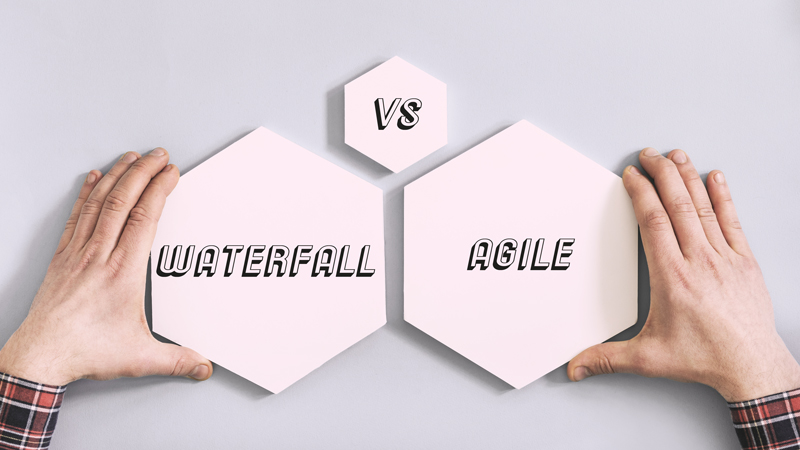
Since organizations are constantly exploring new ways to enhance the way teams work, Waterfall vs. Agile has become one of the more popular debates. Once confined almost exclusively to software development, Agile methodologies are being used by organizations across industries as an alternative to the Waterfall method. But does being popular make Agile a better approach for every organization? In this post, we’re going to look at the differences between Agile and the Waterfall approach, and how you can determine which is the right choice for you.
Choosing the right work management approach
The nature of work is changing. Companies around the world are turning to iteration-driven work like Lean and Agile for a number of different reasons. Some organizations want a system that reduces uncertainty when planning, while others might want the ability to make adjustments that keep their products aligned with customer preferences.
According to a study by Gartner, 45% of organizations are utilizing Agile methods in some way, shape, or form. An additional 12% of organizations are using a hybrid approach that combines iterative work with Waterfall, and only 39% of organizations are strictly using Waterfall.
From this, we can see that many companies are actively thinking about the same questions as you are: How do I start making sense of the Waterfall vs. Agile debate in my organization? Where do I apply Agile – and where is it better to use Waterfall or a Waterfall-Agile hybrid? The answer isn’t as straightforward as you think.
Head to head: Waterfall vs. Agile
Agile and Waterfall are more than two different approaches to managing work. They’re two completely different ideologies. Before you’re able to choose the right method for your organization, you must first understand the differences between the two.
Waterfall approach
One of the reasons why the Waterfall approach has been popular for so long is due to it being simple and easy to understand. With Waterfall, the executives and/or project managers map out the entire project ahead of time, setting the project up in stages and using dependencies and baselines to measure whether work is being executed efficiently. The entire process is heavily planned and documented, with resources and budgets decided upon before the project starts.
The advantage of the Waterfall approach is that it’s easier to regulate. Project managers have almost complete control over the project, and they are able to assign resources and set specific tasks.
Agile approach
Agile is a mindset based on a defined set of 12 principles and four values that teams can engage in by adopting one of several frameworks (e.g., Kanban, Scrum, SAFe, etc.). In fact, some Agile practitioners will tell you that there are as many ways to explain the details of implementing Agile as there are frameworks to embrace the method.
One way to define Agile is to think of it as a completely different approach to work management. Rather than performing planned, milestone-driven work, Agile breaks planning down into smaller chunks of work that are managed by fixed teams. It’s a mindset that focuses on:
- Delivering incremental value to internal/external customers
- Consistently evaluating your performance and plan
- Being able to adjust your plan accordingly, without causing major disruptions
Agile offers an alternative to traditional command-and-control leadership where teams receive all of their directions from management. Teams set their own baseline and capacity under the Agile approach, while management adopts a hands-off role when it comes to daily operations. Instead of directing teams every step of the way, the manager’s job is largely to promote agility and help team members understand their roles and how they fit into the overall picture.
This is why fixed teams are so important under Agile. It allows team members to get to know each other. Over time, they start to have a better idea of what they’re good at, what they can’t take on, and how much time it takes to complete a chunk of work. As these teams mature over time, they become better at making predictions and are less likely to overload themselves.
What’s the right method for me?
So how do you choose a winner in the Waterfall vs. Agile debate? It depends on the nature of your project. The success of your initiatives and your business depends on being able to choose the right method for the right work, for the right people. Before choosing a methodology, ask yourself:
- What kind of work are we taking on?
- Who’s going to be doing that work?
These are two very important questions you need to answer before deciding if you should use Agile, Waterfall, or a hybrid approach. Waterfall comes in handy when you’re looking to deliver milestone-driven work with clear project start and completion dates, like an initial product launch of a new consumer good or a time-bound event (e.g., a user conference). Agile is more suited for work where teams will be working together on a semi-permanent basis and there’s a need for continuous delivery and cross-team alignment, like in application development or when you’re creating marketing content.
You should also consider what your goals and desired outcomes are, and whether Agile, Waterfall, or a hybrid approach will help you achieve those goals. Some organizations switch to Agile with the expectation of immediately seeing faster delivery times, but they often fail to understand that it takes time to see these results. Even though Agile is capable of boosting speed and efficiency and other benefits, it takes time for teams to become comfortable working together and learning how much work they can accomplish within a specified time frame.
On top of that, Agile may not be suitable for everyone. Leaders who thrived in traditional management roles might not be the best candidates to drive Agile transformation. They may be used to hierarchical structures and hands-on management, which aren’t elements of the Agile approach. Instead, teams are given more autonomy over their planning and delivery. Management and executives define the goals, and it’s up to the teams to define the tasks and plan the work that needs to be done to reach those goals.
Final Thoughts
Waterfall can be useful for one-time projects, while Agile works well with work that demands continuous delivery. Ongoing projects give teams the time to learn more about their roles and what they’re capable of delivering within a chunk of work. Moreover, breaking work down into iterative chunks enables quicker feedback loops, which make it easier to update your product so it stays aligned with customer preferences.
If you’d like to learn more about Waterfall vs. Agile and which approach is right for your organization and when, watch our on-demand webinar titled “Agile or Waterfall – Choose the Right Methodology for Success.” This will help you gain more insight into the advantages of both approaches, as well as help you with setting up an Agile or hybrid approach of your own. It’s important to keep in mind that there’s no such thing as a one-size-fits-all solution to managing work.



![A Global Collaborative Work Management Blueprint [Video]](https://blog.planview.com/wp-content/uploads/2019/07/A-Global-Collaborative-Work-management-blueprint.png)

